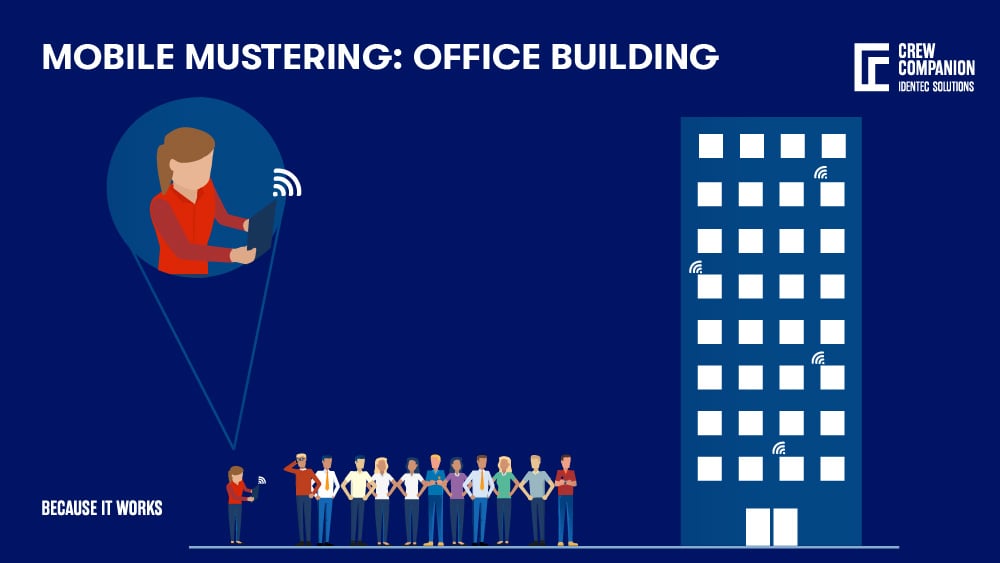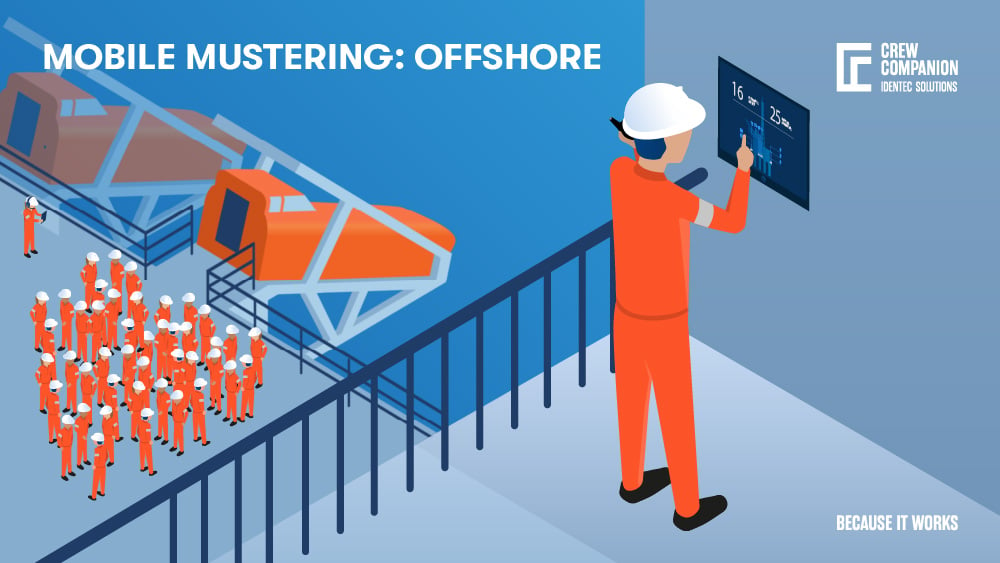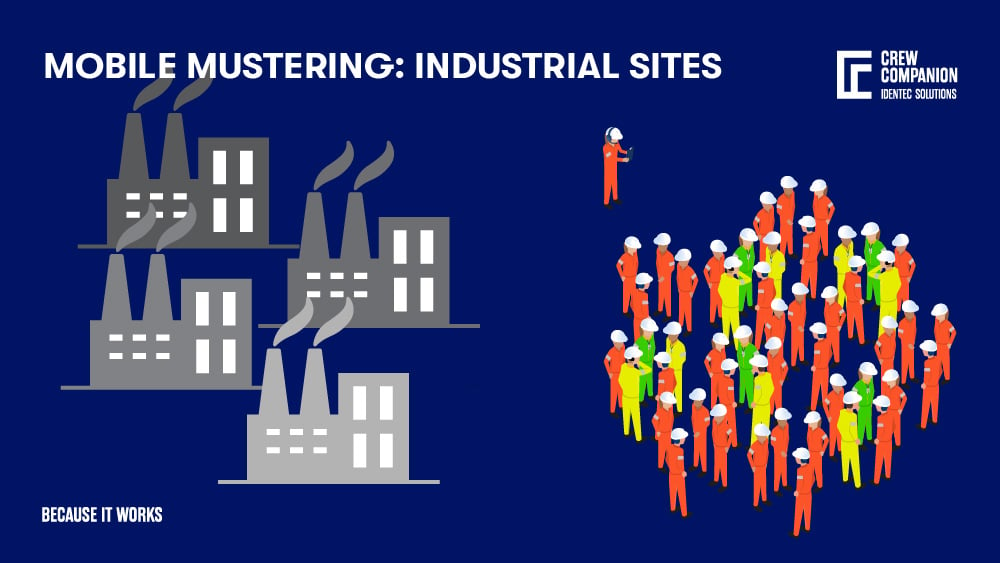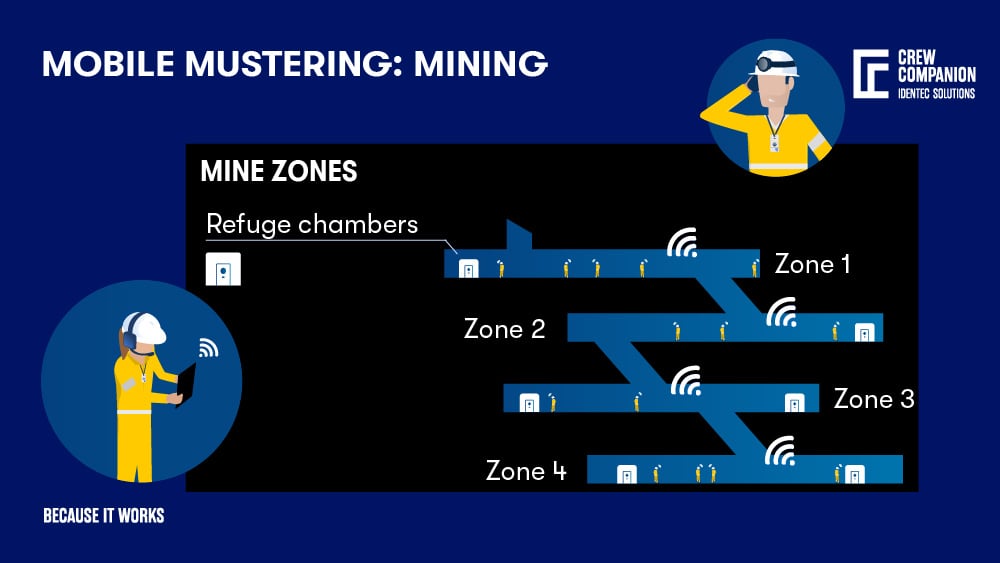Mobile mustering: offshore and onshore
| Written by David Gordon
Emergency mustering has one purpose: To safely evacuate people during a crisis or emergency. Emergency mustering systems typically include diverse technologies, such as dedicated phones, worker badges with RFID chips, and automated messaging capabilities. The top-notch mustering systems also contain employee tracking features that provide valuable information for post-incident analysis.

No video selected
Select a video type in the sidebar.
Table of contents:
- What Is Mobile Mustering?
- Mobile Mustering: Why Use It
- Mobile Mustering: Which Industries Are Using It
- Takeaway
WHAT IS MOBILE MUSTERING
By enabling fast and efficient employee coordination and communication, mustering systems help ensure that everyone can safely evacuate a building or facility in an emergency. But with mounting pressure from OSHA to account for workers during an emergency and budget shrinking, mustering must not only be part of an organisation's emergency plan but also be accomplished with fewer resources.
The basic requirements for mobile mustering include a rugged, lightweight handheld computer that can serve as (1) a mobile mustering list and (2) a mobile mustering reader. In addition, depending on the intended use, sometimes it is beneficial to be capable of reading a specific format such as smart cards, PIV, HID Prox, iClass and bar codes.
A real-time location system delivers a comparatively automated mustering method with minimal human interference. Since RTLS shows the location of each person on the system in real-time, evacuees do not need to present themselves at the mustering area and swipe their credentials. Additionally, the system can provide information about the individual's well-being, on-site environmental conditions and movement in unauthorised areas. This vital information can assist first responders in reaching personnel quickly and with the necessary medical supplies.
This type of personnel tracking is a highly effective mustering solution for larger premises, particularly if personnel are trapped in the premises and need to be rescued.
A handheld device allows for mobile mustering, which can be carried out at any location, not necessarily at the site's assembly point. The handheld device looks like a mobile phone or tablet and functions as a handheld reader. Evacuees are accounted for by simply swiping their card on the device or being close to a reader, registering them against the list of personnel on the site's access control system. A list of unaccounted-for personnel is generated automatically and contains each person's last recorded location, providing vital details for first responders on a rescue mission.
These devices can be powered over Wi-Fi, mobile network or stand-alone mode and generally come with an integrated card, fingerprint or face verification sensors. The essential advantage of using a handheld device is the flexibility it provides for the location of the mustering point (see: emergency mustering).

MOBILE MUSTERING: WHY USE IT
Imagine an emergency scenario — fire, bomb threat, gas leak — in which you must evacuate your building. The proper alerts have been sounded, people have arrived at the mustering location, and first responders are on the scene. But how do you know if everyone made it out? And where are the ones who remained inside?
Emergencies are just one of two main reasons to use mobile mustering solutions. The second: Training/mustering drills. In both scenarios, flexibility and real-time data accuracy are the key components of a proper (mobile) mustering solution.
In the past, security personnel may have grabbed a printed evacuation list on the way out to ease the manual counting and sorting of employees. Advancing to laptop computers allowed automating the process. Still, laptops often take precious minutes to start up and are data-dependent on the physical access control system (PACS), which may not be online during an emergency.
Mobile mustering, which uses portable handheld computers that work online or offline, is equipped with card readers to scan IDs and quickly assess mustering progress and statistics. The better idea is that they check a dedicated zone automatically and show the mustering officer who arrived in the muster area without any manual intervention. Because emergencies evolve quickly, data integrity is the top priority in mobile mustering. However, it comes down to this: Tracking employees and first responders quickly during crises can save lives.
At its core, a mobile mustering system involves deploying sensors or other tracking devices throughout the workplace to monitor employee movements. These sensors then relay information about employee location back to a central hub for analysis and decision-making. The benefits of using an employee mustering system include:
- Real-time tracking is one of the most significant benefits of using a mobile mustering system. With this system, staff data is collected and transmitted in real-time so that organisations can track workers' whereabouts at all times. This is especially beneficial in an emergency, as it can help organisations quickly identify where employees are located and ensure their safety.
- Enhanced accuracy is another benefit of using such an IoT-based mustering system. This system relies on precise sensors to collect employee data, which means that the data collected is more reliable than data collected manually. This is important in an emergency, as accurate data can be used to make decisions that could save lives.
- Scalability is another benefit of using an employee mustering system. This type of system can be easily scaled to meet any organisation's needs, making it a good choice for organisations with large or growing employee populations. Additionally, organisations can often customise an IoT system to account for unique needs and requirements.
The tablet or mobile phone for mobile mustering should withstand the elements and rough treatment since they are likely to be used outside. Rugged handheld tablets should be sealed against dust and liquids to at least IP65, operate in temperatures ranging from -20°C to 50°C and survive a 1-meter drop to concrete. They also should offer a sunlight-viewable display.
Read more about Emergency Response Offshore...

MOBILE MUSTERING: WHICH INDUSTRIES ARE USING IT
Cruise Ships
The international maritime treaty known as SOLAS, or Safety of Life at Sea, requires the muster drill for everyone on board. The first version of SOLAS dates back to 1914, implemented in response to the sinking of the Titanic in 1912.
Since then, a muster drill has been a mandatory safety exercise to familiarise all guests and crew with the location (muster station) where they are to assemble in the event of an emergency. It also prepares passengers for safe evacuation on the ship in an emergency and familiarises the crew and the passengers with escape routes. In a muster drill, the use of life vests and the escape routes from the vessel are explained to the passengers.
Because of COVID-19, large, shipwide gatherings became impossible. The digital muster drill was introduced as an innovation by Royal Caribbean in 2020, and the idea of a smartphone-based muster has been embraced throughout the industry. Passengers completed safety information on their smartphones and visited their designated muster stations in person to check in. Staff members scanned keycards to check passengers in, and the process was complete.
The new system's convenience to passengers is the most significant advantage of the new digital muster drills- apart from the obvious COVID-era benefits. And in most cases, that comfort starts with the cruise line's smartphone app. Passengers can watch the muster drill and listen to the emergency signal on their mobile devices using the cruise lines' apps. And they can do it several hours before boarding. Then, once on board, they only have to check in at the physical muster station to finish the process.
However, mobile mustering on cruise ships is applicable not only for muster drills but also for emergency scenarios. In a nutshell, it simplifies the crew's access and tracking of guests and crew movement. In addition, it is ideal for handling significant crowd movement as it provides an accurate headcount and real-time passenger, crew, and visitor status. In combination with fixed-installed readers at muster stations and lifeboats, both mobile mustering solutions (mobile POB list and mobile reader) enhance overview, mustering and real-time situational awareness.
Office Buildings
Imagine an evacuation during a fire at a large commercial office building to get an idea of how an emergency mustering solution works. If the building had handheld badge readers, people could scan their ID badges as they evacuated using one of the wireless handheld devices held by an evacuation captain. Then, as more and more people began to reach safety, system administrators could watch the live list of people accounted for or missing. And if someone was missing, the handheld devices could show where that person's last documented location was.
This technology can assist an emergency response team in determining the best course of action. For example, the scenario above would allow first responders to determine whether or not they need to enter a burning building to save a missing person. The technology can be used as a stand-alone system or integrated with a company's access control system. An integration would additionally allow a facility to authorise visitors, keep track of where and when they entered the building, and see how long they were in a specific location.
The abovementioned solution has only one problem: Long queues. It will take a few moments per card to read if you need to touch the reader with a badge or visually recognise a barcode. The short waiting period accumulates and creates potentially dangerous situations. People will hastily leave the queue and not "check in", making the collected data inaccurate. A much better solution is to avoid any "manual" interaction with a reader and automatically read a zone like a gate, corridor or muster area. There are no queues, and there is no missing data.
Outside of the building, muster areas may be obscured, or people may leave the area in panic. A mobile reader will help check whether individuals belong to the affected building or are only bystanders and eventually update the mustering database.
Mass events
A particular type of office building scenario is a mass event. Events are temporary; therefore, there is no time to practice mustering, but a short introduction to the safety of the event or area can be provided. Because of the huge crowds, mass gatherings are sometimes considered critical. Disasters like mass panic and stampedes have caused many fatalities in the past.
Emergency scenarios include fire, flood, earthquake, civil disturbance, explosions, or severe weather (e.g. a tornado). Typically, an emergency management plan prepares for such an eventuality and outlines preparedness and mitigation as well as the response and recovery after such an incident. Every emergency management plan is different, but there are some similarities: the emergency services and organisers must know the identities of all visitors to conduct mustering, accounting and, if necessary, search & rescue missions. An automatic transponder system with real-time location would be a game changer for emergency organisations: mobile mustering would happen on the fly, indicating people who have left the area and showing unaccounted visitors. Teams with mobile readers could swarm out and "collect" unaccounted visitors.

Industrial sites
More than one muster point will be required if your workplace is a large industrial site or a complex facility like a university or a hospital. Sometimes, muster areas are determined by floor, department, or building area. In these cases, you must ensure all workers know which muster point is assigned to their facility area to minimise overcrowding and confusion during egress. It is also necessary to let workers know that muster points are assigned to an area of the workplace, not individual workers. Therefore, when workers move around the building or worksite, they must use the muster point set to the place they are in at the time, not attempt to get back to the one given to their usual post.
Therefore, it is crucial to know precisely where your employees, contractors, and visitors are at any time. In an emergency, a mobile mustering system automatically counts personnel at muster stations but also creates real-time data at gates, surveying strategic corridors and doorways. Additionally, the system will indicate "lost" personnel at a not-assigned mustering point, updating the database on the fly and producing a mobile list of 'real' missing personnel on each mobile device.
Offshore installations
Offshore installations differ from onshore buildings or areas in one crucial aspect: There is no way to go except to stay at the structure or abandon it by boat/raft, or helicopter. With a set of fixed readers at strategic points like mustering areas, lifeboats, bridges or main corridors, RFID-based mustering solutions can track and monitor personnel in real-time. The mustering process and the boarding of lifeboats in an emergency can be supported by mobile devices to show personnel who are attending. A mobile reader may be beneficial as (1) a backup if the installed reader is damaged or destroyed, or (2) to scan areas not pre-fitted with readers at all.
Mining
Underground mining is a world for its. Kilometres of tunnels, shafts and caves create a complex and vast maze. Knowing where your people are is vital, not only during an emergency. During operations, miners regularly muster for safety reasons: before a scheduled blast may occur, everyone must leave and be accounted for in a safety zone or shelter. Blasting is dangerous and triggers rockfall, earthquakes, and gas releases.
For this reason, mobile teams check the access to shafts before an explosion. In addition, mobile readers are used to doing ID checks - who is allowed in a particular area of the mine and registering the worker's identity, feeding the real-time mustering database even before muster happens.

TAKEAWAY
Cruise ships, extensive facilities, mass events, big office buildings, offshore installations and mines must prepare for an emergency evacuation scenario. When safety managers use traditional mustering methods, inaccurate data will lead to dangerous situations for personnel, visitors and rescue teams. Chaos will force everyone involved to make uninformed decisions. A mobile mustering solution based on automatic scanning of the entire area will provide a much better overview of the situation and help direct teams where needed. A solution like Crew Companion will create safer work environments and help personnel go home safely.
Dive deeper into Emergency Response Management!
Note: This article was updated on the 19th of August 2025. The head image was created with Canva.





